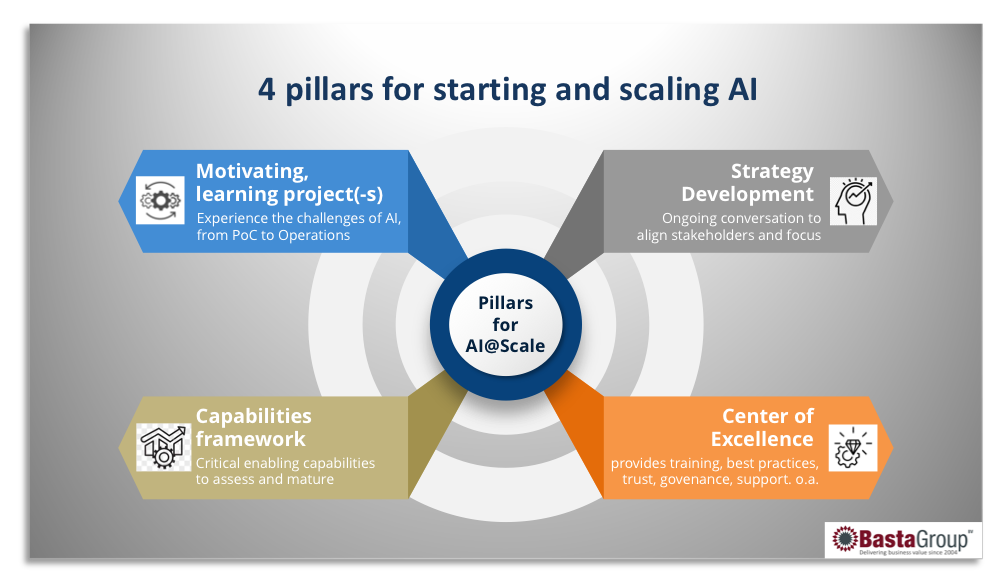
Value Creation with Artificial Intelligence
Our society creates petabytes of data, making predictions and improving decision-making processes. Discovering patterns in combined data is important for business, government and scientific institutions, offering great potential. Data and technology form an inseparable duo. But if you want to grow as an organization with AI, be competitive and create value, you need to organize more things efficiently and professionally.
Starting too quickly as a pitfall
Often, an AI project is enthusiastically started somewhere in the organization. And that is good, because this is how the learning process gets started. But there are also risks hidden in this enthusiasm; the organization may not be ready yet or solutions will be created without involving the business. Due to insufficient internal consultation and the unnoticed start-up of several AI projects, proliferation of different AI tooling can occur. Without a structure, AI projects remain in the "home cook" phase. As a home cook, you can be very good but scaling up to the quality and quantity of a ‘3 star kitchen’ is difficult.

An integrated approach to AI based on 4 pillars
Organizations that want to be competitive and really want to create value with AI applications must grow from the 'home cook' phase to the '3-star kitchen' phase. In this phase, all chefs know the planning and know exactly how to work (and together!). The language, tools and communication are unambiguous, the processes coordinated and the workflow organized, suppliers and products central and always of good quality and so on. The metaphor may be clear.
Many organizations want to grow to a more professional level, but lack the knowledge, experience and, above all, practical tools to start this growth process.
Advanced insight based on many customer projects and conversations, extensive literature research (HBR, Gartner, MITSloan and McKinsey, among others) and internal discussions have yielded a working integral 4-pillar approach to start and accelerate value creation with AI in the organization. There is certainly no one-size-fits-all approach, but the 4 pillars provide a good structure.
Pillar #1: Projects to learn and motivate
Finding and starting the first projects is necessary to experience in practice what problems and limitations you encounter when implementing an AI solution. Also start small, and then build on to more complex solutions. This way you can show that AI can really make a contribution and you make the organization more enthusiastic. Nor does it turn the other pillars into an ivory tower exercise. It also gives you a better insight in building the business case and makes it increasingly reliable.
Pillar #2: Strategy development
To grow from a home cook to a 3-star kitchen you need a strategy. Strategy is determining how to get from A to B and what to do for that. This pillar uses the “Data & AI Strategy development cycle”, which offers you a handle in the strategic thinking process and the steps you need to take. And that starts with vision, ambition and alignment with the business because AI is not an end in itself, it is an enabler for overall business objectives. You also need a capability framework for a good strategy.
Pillar #3: Capabilities framework
Organizations that want to create value will have to take a critical look at which capabilities (knowledge and skills in an organization) are needed and must be developed to grow towards the 3-star phase, the AI maturity. For this we have developed the “Data & AI Capabilities framework”.
Within this framework, the 10 important capabilities are identified that, if you want to go further, better, faster, smarter with AI, you have to become increasingly professional in order to support the ambitions of the organization. Important are the availability of data, the skills of employees, the presence of the right technology, metrics to measure impact, but also leadership, culture and change appetite within the organization.
With an online assessment we provide insight into the level of maturity of each capability.
Pillar #4: AI Center of Excellence
The dilemma of "working in the business" or "working on the business" is overcome with an AI Center of Excellence. A CoE has an organizing, coordinating and supporting role in starting and accelerating AI in the organization. The CoE connects projects, strategy and framework development. CoE supports, among other things, clear language use, training, information, selection of tools and technology and reuse of components. A fit-for-purpose CoE starts small and can already structure the AI activities to scale up faster and more efficiently.
What stage of AI is your organization in?
Scaling up AI in an organization is not a straightforward linear process. And no organization is alike. The activities in the 4 pillars are interrelated and influence each other. A change in one requires an adjustment in the other and sometimes a step back. But starting and accelerating AI in a thoughtful and efficient manner is possible with this generic 4-pillar model that realizes the transformation to an AI-driven organization.
Are you interested to learn more? Sign up for our Artificial Intelligence (AI) Strategy for Business Professionals Virtual Learning course.
We can determine together what phase your organization is in: home cook or 3-star kitchen? Or elaborate on the details of the 4-pillar model. We can help with the steps needed to achieve that 3 star status: helping with the first projects, developing the strategy, defining the right capability framework and/or creating a CoE.
Related Articles

Keeping It Safe: How to Protect the Systems That Run Our Lives
Imagine a world where you wake up one morning to find your air-conditioning…

Data Security in the Age of Ransomware
In the current era of cyber insecurity and the associated everyday dangers…

What Can Pandemics Teach Us About Cyber Security?
We are living in a world in which we have either embraced technology,…

Resisting the Persistent Threat of Cyber Attacks
Delivering agile cyber-defense is now a must, with the recognition that…